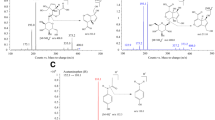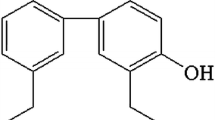Abstract
To investigate the pharmacokinetics of [6]-shogaol, a pungent ingredient of Zingiber officinale Roscoe, the pharmacokinetic parameters were determined by using 14C-[6]-shogaol (labeled compound) and [6]-shogaol (non-labeled compound). When the labeled compound was orally administered to rats, the maximum plasma concentration (C max) and the area under the curve (AUC) of plasma radioactivity concentration increased in a dose-dependent manner. When the labeled compound was orally administered at a dose of 10 mg/kg, 20.0 ± 1.8% of the radioactivity administered was excreted into urine, 64.0 ± 12.9% into feces, and 0.2 ± 0.1% into breath. Thus, more of the radioactivity was excreted into feces than into urine, and almost no radioactivity was excreted into breath. Furthermore, when the labeled compound was orally administered at a dose of 10 mg/kg, cumulative biliary radioactivity excretion over 48 h was 78.5 ± 4.5% of the radioactivity administered, and cumulative urinary radioactivity excretion over 48 h was 11.8 ± 2.7%, showing that about 90% of the dose administered orally was absorbed from the digestive tract and most of the fecal excretion was via biliary excretion. On the other hand, when the non-labeled compound [6]-shogaol was orally administered, the plasma concentration and biliary excretion of the unchanged form were extremely low. When these results are combined with those obtained with the labeled compound, it would suggest that [6]-shogaol is mostly metabolized in the body and excreted as metabolites.






Similar content being viewed by others
References
Yoshikawa M, Chatani N, Hatakeyama S, Nishino Y, Yamahara J, Murakami N (1993) Crude drug processing by far-infrared treatment II. Chemical fluctuation of constituent during the drying of Zingiberis Rhizoma. Yakugaku Zasshi 113:712–717
Kano Y (1987) Chemistry of ginger and dried ginger rhizome. J Tradit Sino-Jpn Med 8:51–56
Aburada M (1987) Pharmacology of ginger and dried ginger rhizome. J Tradit Sino-Jpn Med 8:45–50
Suekawa M, Yuasa K, Isomo M, Sone H, Ikeya Y, Sakakibara I, Aburada M, Hosoya E (1986) Pharmacological study on ginger (Report IV): the effect of [6]-shogaol on arachidonic acid metabolism. Folia Pharmacol Jpn 88:263–269
Jolad SD, Lantz RC, Chen GJ, Bates RB, Timmermann BN (2005) Commercially processed dry ginger (Zingiber officinale): composition and effects on LPS-stimulated PGE2 production. Phytochemistry 66:1614–1635
Hashimoto K, Kase Y, Murata P, Kido T, Nakai Y, Sakakibara I, Higuchi M, Sasaki H, Okada M (2002) Pharmacological evaluation of Shokyo and Kankyo (1). Biol Pharm Bull 25:1183–1187
Hashimoto K, Satoh K, Murata P, Makino B, Sakakibara I, Kase Y, Ishige A, Higuchi M, Sasaki H (2002) Component of Zingiber officinale that improves the enhancement of small intestinal transport. Planta Med 68:936–939
Galal AM (1996) Antimicrobial activity of 6-paradol and related compounds. Pharm Biol 34:64–69
Bode AM, Ma WY, Surh YJ, Dong Z (2001) Inhibition of epidermal growth factor-induced cell transformation and activator protein 1 activation by [6]-gingerol. Cancer Res 61:850–853
Kano Y, Saito K, Tanabe M, Yasuda M (1987) On the evaluation of the preparation of Chinese medicinal prescriptions (2)[6]-shogaol in steam dried “Ginger”. Shoyakugaku Zasshi 41:277–281
Kano Y, Saito K, Tanabe M, Yasuda M (1989) On the evaluation of the preparation of Chinese medicinal prescriptions (4) determination and availability of [6]-gingerol and [6]-shogaol. Shoyakugaku Zasshi 43:7–12
Yoshikawa M, Hatakeyama S, Chatani N, Nishino Y, Yamahara J (1993) Qualitative and quantitative analysis of bioactive principles in Zingiberis Rhizoma by means of high performance liquid chromatography and gas liquid chromatography. On the evaluation of Zingiberis Rhizoma and chemical change of constituents during Zingiberis Rhizoma processing. Yakugaku Zasshi 113:307–315
Jiang H, Sólyom AM, Timmermann BN, Gang DR (2005) Characterization of gingerol-related compounds in ginger rhizome (Zingiber officinale Rosc.) by high-performance liquid chromatography/electrospray ionization mass spectrometry. Rapid Commun Mass Spectrom 19:2957–2964
Ding GH, Naora K, Hayashibara M, Katagiri Y, Kano Y, Iwamoto K (1991) Pharamacokinetics of [6]-gingerol after intravenous administration in rats. Chem Pharm Bull 39:1612–1614
Naora K, Ding G, Hayashibara M, Katagiri Y, Kano Y, Iwamoto K (1992) Pharamacokinetics of [6]-gingerol after intravenous administration in rats with acute renal or hepatic failure. Chem Pharm Bull 40:1295–1298
Nakazawa T, Ohsawa K (2002) Metabolism of [6]-gingerol in rats. Life Sci 70:2165–2175
Surh YJ, Lee SS (1992) Enzymatic reduction of shogaol: a novel biotransformation pathway for the alpha, beta-unsaturated ketone system. Biochem Int 27:179–187
Surh YJ, Lee SS (1994) Enzymatic reduction of xenobiotic alpha, beta-unsaturated ketones: formation of allyl alcohol metabolites from shogaol and dehydroparadol. Res Commun Chem Pathol Pharmacol 84:53–61
Zick SM, Djuric Z, Ruffin MT, Litzinger AJ, Normolle DP, Alrawi S, Feng MR, Brenner DE (2008) Pharmacokinetics of 6-gingerol, 8-gingerol, 10-gingerol, and 6-shogaol and conjugate metabolites in healthy human subjects. Cancer Epidemiol Biomarkers Prev 17:1930–1936
Bhattarai S, Tran VH, Duke CC (2007) Stability of [6]-gingerol and [6]-shogaol in simulated gastric and intestinal fluids. J Pharm Biomed Anal 45:648–653
Pfeiffer E, Heuschmid FF, Kranz S, Metzler M (2006) Microsomal hydroxylation and glucuronidation of [6]-gingerol. J Agric Food Chem 54:8769–8774
Author information
Authors and Affiliations
Corresponding author
Additional information
A. Asami and T. Shimada contributed equally to this work.
Rights and permissions
About this article
Cite this article
Asami, A., Shimada, T., Mizuhara, Y. et al. Pharmacokinetics of [6]-shogaol, a pungent ingredient of Zingiber officinale Roscoe (Part I). J Nat Med 64, 281–287 (2010). https://doi.org/10.1007/s11418-010-0404-y
Received:
Accepted:
Published:
Issue Date:
DOI: https://doi.org/10.1007/s11418-010-0404-y




